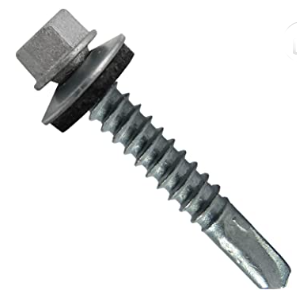Gable Roof Calculators
- Gable Roof Area: This computes the surface area of a gable roof based on dimensions and pitch.
- Trusses Needed for Roof: This computes the number trusses need for a roof including gabled roof.
- 4x8 Sheathing for Gable Roof: This computes the total surface area of a roof, the number of 4x8s and framing nails needed for a gabled roof based on the length, span, pitch and overhang.
- Gable Roof Sheathing Cost: This computes the number of 4x8 sheets (32 ft² each) needed to cover a gabled roof based on the ridge length, roof span, overhang and the pitch and applies the unit cost of a 4x8.
- Nails for Gable Roof Sheathing: This computes the approximate number of nails needed to nail 4x8 sheets to trusses or rafters on a roof based on the dimensions of the roof, spacing of nails on the edges and field of the 4x8, and whether blocking or clips are use.
- Purlins for Gable Roof: This computes the total number and length of purlins for a simple gable roof based on the ridge length of the roof, the roof pitch and the span of the roof.
- Metal for Gable Roof: This estimates the metal panels and trim needed for a metal roof for a simple gabled roof based on the roof dimensions.

- Metal Screws for Gable Roof: This computes the number of special screws needed for a metal roof.
- Shingles for Gable Roof: This computes the number of shingles (bundles), underlayment, ridge shingles, starter strip, and roofing nails for a gable roof.
- Gable Roof Shingle Cost: This estimates to shingle a basic gable roof based on dimensions (length, span, pitch and overhang) and the unit price of a bundle of shingles.
- Underlayment for Gable Roof: This estimates the cost of underlayment to cover a basic gable roof based on the area of a roof computed from the dimensions (length, span, pitch and overhang) and the unit price underlayment material.
- Roofing Nails for Gable Roof: This estimates the number of roofing nails needed for a common gabled roof based on roof dimensions and wind conditions.
- Rafters for Gable Roof: This computes the total number of rafter boards (roof joists) for a gabled roof based on the ridge length, pitch and span. It also returns the length of the ridge board, and the length and number of rafter ties and collar ties.
- Rafter Length: This computes the length of the rafters based on the span, pitch and overhang.
- Gable Roof Geometries: This computes the length of rafters, pitch and cut angles, soffit and facia base widths of a gable roof.
- Weight of Snow on Roof: This computes the weight of snow on a gable roof based on roof dimensions, depth and type of snow.
Roofing Nail Calculators:
- Roofing Nails for Gable Roof: This computes the number of roofing nails needed for a common gabled roof based on roof dimensions and wind conditions.
- Roofing Nails for a Gambrel Roof: This computes the number of roofing nails to shingle a gambrel roof based on the dimensions and wind conditions.
- Roofing Nails for a Hip Roof: This computes the number of roofing nails to shingle a hip roof based on the dimensions under normal and high wind conditions.
- Roofing Nails for a Double Hip Roof: This computes the number and weight of roofing nails for a hip roof with a hip roof dormer based on the dimensions.
- Roofing Nails for a Shed Roof: This computes the total number roofing nails and their weight to shingle a single sloped roof based on the span, ridge length and the front and back overhangs.
- Roofing Nails for a Dormer: This computes the number and weight of roofing nails needed for one or more roof dormers based on the dimensions.
- Roofing Nails for Irregular Roof Section: This computes the number roofing nails (count and weight) for an irregular section of a roof based on the dimensions.
Roofing Nail Data:
- Roofing Nail Density in Normal Wind: The number of Roofing Nails for a Square of Shingles in normal conditions is 348.
- Roofing Nail Density in High Wind: The number of Roofing Nails for a Square of Shingles in HIGH WIND conditions is 522.
- Weight of Roofing Nails: A single smooth shank 1-1/4" roofing nail weighs 0.00511247443762781 lbs.
Roofing Nail Guidance
Roofing Nails are used to attach shingles to sheathing on a roof. There are two densities used for the number of roofing nails needed per shingle, normal wind and high wind. This can be seen in the shingle diagram to the right. The top image shows four nails per shingle above the tab cuts. This is for normal wind conditions. The lower image shows six nails per single with a double nail above the two central tab cuts. This is for high wind conditions in exposed places like on the edge of bodies of water, on top of mountains or other exposed places with no wind breaks. High winds are experienced in areas with little cover from wind breaks. Such areas include deserts, prairies, mountain tops and areas adjacent to large bodies of water. High winds are also associated with areas prone to hurricanes.
Note that for both normal and high wind applications, the roofing nails go just below the sealant strip.
Roofing nails are sold by weight in many places. The weight of the nails is based on a 5lb box of 1-1/4" smooth shank nails having 978 nails. That's 0.0818 ounces per nail.
Single Price Survey Data
One should use the pricing for roofing materials that can be bought locally. However, the following prices are for different quality grades of shingles in the United States. The 3 Tab and Architectural Shingles Cost Survey lists the observed price of a bundle of shingles. A bundle of shingles is 33.33 ft2 for 3-tab shingles or 32.8 ft2 for architectural shingles. The survey includes a date, the name of the store. the five price points for shingles: economy, low, median, high and premium.
3 Tab and Architectural Shingles
- Shingle Price Survey Online Source : Lowes
- Shingle Price Survey Date: 12/22/22
- Cost of Premium Shingles: $90.0 USD.
- Cost of High Grade Shingles: $52.34 USD.
- Cost of Medium Grade Shingles: $43.32 USD.
- Cost of Low Grade Shingles: $37.98 USD.
- Cost of Economy Grade Shingles: $36.0 USD.
Ridge Shingle and Starter Shingle (strips):
- Price Survey Online Source : Lowes
- Price Survey Date: 12/28/22
- Cost of High Priced Ridge Shingles: $3.51 USD / ft.
- Cost of Medium Priced Ridge Shingles: $2.4 USD / ft.
- Cost of LOW Price Ridge Shingles: $1.42 USD / ft.
- Cost of High Priced Starter Shingles: $1.47 USD / ft.
- Cost of Medium Priced Starter Shingles: $0.93 USD / ft.
- Cost of LOW Grade Starter Shingles: $0.4 USD / ft.
NOTE: Local pricing should ALWAYS, ALWAYS, ALWAYS be used! These price points are for estimation convenience only, and there is no guarantee on the prices of the product nor of their availability at the stated price.
Metal Panel Price Information
Metal Panels for Roofing and Siding Pricing provides the basic pricing survey for metal panel materials.
The Metal Pricing Periodic Survey Data includes the following:
- Date Survey: 3/7/24
- Source of Pricing Source: CN Metals
- Source Web Site: https://www.cnmetalsllc.com/
- Source Phone Number: (301)334-9170
- Cost per Unit:
- [$3.16 USD/ft] - Economy Corrugated Panels (36" wide C-Lok or ag panels) dollars per liner foot
- [$4.48 USD/ft] - Premium Corrugated Panels (36" wide G-Rib) dollars per liner foot
- [$3.19 USD/ft] - Standing Seam Panel (15" wide) dollar per linear foot.
- [$3.19 USD/ft] - Panel (36" wide) - dollars per linear foot
- [$0.09 USD/screw] - Screws (with seal gasket) - dollars per screw
- [$1.74 USD/ft] - Ridge Cap - dollars per linear foot
- [$1.84 USD/ft] - Outside Corner (trim) - dollars per linear foot
- [$1.25 USD/ft] - Snow Rail - dollars per linear foot
- [$2.85 USD/ft] - Drip Edge - dollars per linear foot
- [$0.2 USD/ft²] - Fanfold Insulation - dollars per square foot
Data Sources
The sources of this data include the following:
If you wish to have your data added to the list, contact vCalc via the "Contact Us" option to your right.
CAUTION: The pricing information provided is for calculating convenience with NO implied guarantees to the accuracy of the values listed. Authoritative sources should be sought to confirm any value before risking health or wealth on the veracity of the data. Furthermore, Calc gives no guarantee that you will be able to buy products at listed prices or even if they will be available. The data provided is purely a convenience for making estimates, so we repeat, ALWAYS use local pricing and authoritative specifications.
